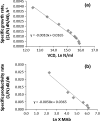Revisiting Verhulst and Monod models: analysis of batch and fed-batch cultures
- PMID: 25805268
- PMCID: PMC4371576
- DOI: 10.1007/s10616-014-9712-5
Revisiting Verhulst and Monod models: analysis of batch and fed-batch cultures
Abstract
The paper re-evaluates Verhulst and Monod models. It has been claimed that standard logistic equation cannot describe the decline phase of mammalian cells in batch and fed-batch cultures and in some cases it fails to fit somatic growth data. In the present work Verhulst, population-based mechanistic growth model was revisited to describe successfully viable cell density (VCD) in exponential and decline phases of batch and fed-batch cultures of three different CHO cell lines. Verhulst model constants, K, carrying capacity (VCD/ml or μg/ml) and r, intrinsic growth factor (h(-1)) have physical meaning and they are of biological significance. These two parameters together define the course of growth and productivity and therefore, they are valuable in optimisation of culture media, developing feeding strategies and selection of cell lines for productivity. The Verhulst growth model approach was extended to develop productivity models for batch and fed-batch cultures. All Verhulst models were validated against blind data (R(2) > 0.95). Critical examination of theoretical approaches concluded that Monod parameters have no physical meaning. Monod-hybrid (pseudo-mechanistic) batch models were validated against specific growth rates of respective bolus and continuous fed-batch cultures (R(2) ≈ 0.90). The reduced form of Monod-hybrid model CL/(KL + CL) describes specific growth rate during metabolic shift (R(2) ≈ 0.95). Verhulst substrate-based growth models compared favourably with Monod-hybrid models. Thus, experimental evidence implies that the constants in the Monod-hybrid model may not have physical meaning but they behave similarly to the biological constants in Michaelis-Menten enzyme kinetics, the basis of the Monod growth model.
Figures








References
-
- Alexander M. Biodegradation and biomediation. 2. London: Academic Press; 1999.
-
- Bailey JE, Ollis DF. Biochemical engineering fundamentals. Singapore: McGraw-Hill; 1986.
-
- Bi J-X, Shuttleworth J, Al-Rubeai M. Uncoupling of cell growth and proliferation results in enhancement of productivity in p21CIP1-arrested CHO cells. London: Wiley; 2004. - PubMed
-
- Brown D, Rothery P (1993) Models in biology, mathematics, statistics and computing. Wiley, Chichester, UK
LinkOut - more resources
Full Text Sources
Other Literature Sources

